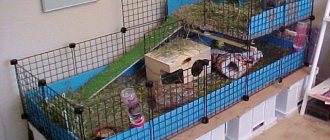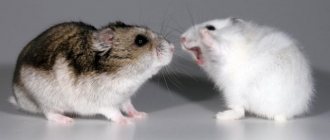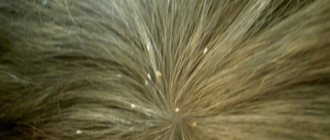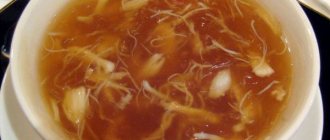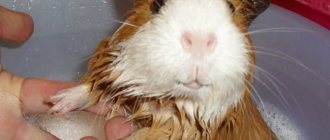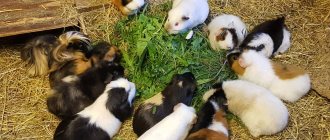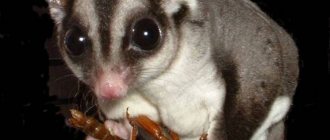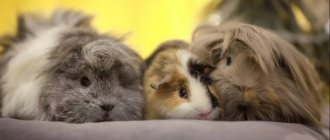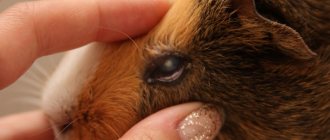- home
- Guinea pig
- Choosing and purchasing a guinea pig
03/01/2019 Often, a guinea pig is chosen as a pet for a number of advantages, the main one of these advantages is the smell from the guinea pig, namely its complete absence. Experienced owners of such animals assure that with proper care, the fluffy will only produce the smell of fresh hay.
However, some inept breeders leave angry reviews, saying that guinea pigs stink. Who to believe? Of course, to people who know. If your pet produces an unbearable odor, it means that something is wrong and this smelly nuisance needs to be corrected.
Natural smells of guinea pigs
Guinea pigs, like other animals, have a unique smell. By nature, these animals are very clean, and their smell is quite tolerable. This quality is protection. They do not have sharp claws, fangs or other attributes for self-defense, so they do not emit pungent odors so as not to attract predators.
When do guinea pigs smell:
- Males - when excited, court the chosen one and mark the territory;
- Females - after childbirth due to hormonal imbalance;
- Ear infection – normally the earwax is gray and odorless, if the earwax turns red and has an odor, the pet should be taken to the veterinarian;
- The pig is not healthy - an unpleasant odor can be a symptom of certain diseases;
- Sanitary standards for keeping rodents were violated.
Owner experience and reviews
Before getting a guinea pig, a future breeder needs to decide on the gender of the animal. Males smell stronger than females . This fact should be taken into account before purchasing an animal.
Julia
“When you take any living creature into your home, you must be prepared for the fact that it needs cleaning, care, games, etc. With each individual. Here we had hamsters. They stink terrible! And now there’s a guinea pig, my daughter couldn’t be happier, and again, if you clean it up, it doesn’t stink! It’s like with a cat, what will happen if its potty is not removed?”
Maria
“What they say is correct, you need to clean it up, then it won’t stink. We bought a guinea pig, and an Angora pig, and everyone tried to dissuade us! Like, the guinea pig stinks in the apartment, the poop sticks and lives for three years!!! They changed the cage every day, fed fresh vegetables and special food. feed! Washed and cut once a week!!! At least one allergy sufferer (who was visiting) understood that we have this happiness. Gosha lived for almost 8 years! We were thinking about a replacement, the family decided that there was no equal!
So, if you love and care for the one you have tamed, the maggot will become clean and loved. Be kinder!"
If an unpleasant odor still settles in your pet’s cage, you can resort to special means. You can find many sprays at the pet store that eliminate urine odor. Before use, the cage must be washed and treated with the drug. After the exposure time specified in the instructions, the product is removed from the surface of the tray and wiped dry.
By maintaining proper hygiene in the guinea pig's cage, the owner will not encounter the problem of unpleasant odor, and the pet will enjoy good health for a long time.
How to avoid unpleasant odor
If you keep your pet clean and monitor its health, then the animal will not stink.
Systematic neglect of cleaning the territory in which the animal is located can lead not only to the appearance of an unpleasant odor from the cage and the animal itself. Colds and baldness may also occur. A fungus will appear in the cage and fly larvae will appear.
External features
The body length of an adult guinea pig ranges from 25 to 35 cm (depending on the breed). These rodents do not have a tail. Thoroughbred individuals have drooping ears and a wide, blunt muzzle. A male guinea pig weighs from a kilogram to one and a half, and a female - from 800 grams to 1.2 kg.
Today, many breeds have been bred that differ in the length, structure and color of their coat. Breeds of guinea pigs (domestic) are divided into groups:
- short-haired (Crested, Smooth-haired, Selfie);
- longhaired (Texel, Sheltie, Merino, Peruvian, Rosette);
- Wire-haired (American Teddy, Rex, Abyssinian);
- breeds are hairless and with a small amount of wool (skinny, baldwin).
The body of domestic pigs differs from their wild counterparts in having more rounded shapes.
Cleaning the cage
Cleaning the pig's home should be done regularly. Weekly general cleaning is needed: replacing the filler, washing the bottom of the cage with a soap solution (baby or laundry soap is suitable) and wiping with a 10% vinegar solution. Vinegar is good at removing unpleasant odors and white stains from urine. Contaminated litter and toilets must be cleaned every day. Bowls and drinking bowls are also cleaned daily with soap. Wooden products are washed only when dirt appears, and then dried well.
It is recommended to clean the cage with a special disinfectant spray that eliminates odor. The product can be purchased in specialized stores; it will not harm the health of the animal. Before spraying, the pig is removed from the home and the filler is removed. 5 minutes after spraying, wipe the cage with a towel. After complete drying, the house is filled with clean filler. The animal returns to its place.
It is prohibited to use bleach-based products. In addition to the pungent odor, such a solution can harm the health of your pet.
If a PVC mat is used, it must be washed when it gets dirty. It is better to purchase at least 2 rugs so that you can replace one with another while the second one is drying. The bedding can be washed in a machine at a temperature of 40-60 ⁰C. The service life of a PVC mat is no more than half a year.
Treatment of parosmia
To begin with, drug treatment is used. Physiotherapeutic hardware techniques can be prescribed in combination.
If medications do not work, surgery to remove the damaged sensory receptors (olfactory mucosa) in the nasal cavity will be considered.
When looking for alternative conservative ways to treat parosmia, you can try olfactory training: inhaling a certain smell and remembering what that smell should smell like. So, if you smell a lemon, you should think about what a real lemon smells like.
Reviews indicate that this may be an effective treatment for parosmia. In a recent study, patients who exercised for six months showed clinically significant improvements in their ability to accurately smell.
As for how to treat parosmia after covid, there is no specific specific therapy. It is treated in the same way as any parosmia caused by a viral infection. In many cases, parosmia after coronavirus can partially or completely go away without treatment at all.
The ENT clinic in Chertanovo treats parosmia, including those caused by Covid, using the full range of highly effective conservative treatment methods.
Toilet training
Keeping the cage clean is much easier if the animals are toilet trained. The place for its installation must be chosen by the pet himself. It is necessary to track in which corner the filler is most often moistened and place a corner toilet there. Used bedding and feces should be placed in a new container to make it easier for the animal to navigate. When your pet relieves itself in a designated area, you need to reward it with a treat. It happens that the pig ignores the toilet, in which case it is better to move the container to another place.
Washing the toilet can be accompanied by baking soda. It is also recommended to pour baking soda into the bottom of the bowl, this helps eliminate the stench.
Litter for rodent litter should be natural. Sawdust or other wood material is ideal. Products for cats should not be used. There are fillers with odor absorbers.
Bottle with drinker
Such an accessory will come in handy during street walks. It does not take up much space, weighs little and does not hinder movement. But you can offer the dog to quench his thirst at any time, and not wait until he starts drinking from a dirty puddle or lake overgrown with mud.
The device consists of a water container and a bowl equipped with a dispenser button. It allows you to release as much liquid from the bottle as the animal needs to quench its thirst. Sold in two volume options - 350 and 550 milliliters.
Price – 475 – 584 rub.
Another model of the same device has a folding shape, which makes it easier to carry. The transformer connects the bowl and the bottle, securely fixing them in such a compact state. The durable polymer material has good shockproof properties and can even resist dog teeth. True, this struggle will not be long and - if the owner is careless - then all the liquid will end up on the ground.
Volume 250 ml.
Cost – 133 – 148 rubles.
I like1I don't like
Water treatments
Guinea pigs keep their fur clean on their own.
- You should bathe the animal only when absolutely necessary, preferably after a veterinary examination. After taking a bath, your pet should be wrapped in a warm towel to prevent it from getting sick.
- Routines such as trimming and brushing will also help maintain hygiene. You can clean the animal using a soft toothbrush.
- You should not bathe your guinea pig with regular shampoo or cleaning products. For a rodent, you should purchase a special product.
- You need to accustom your pet to a bath gradually, starting with a minimum amount of water. You can consolidate the result with a treat.
- Water procedures are carried out no more than once every 30 days. From frequent bathing, the animal's sebum will be washed off and bald patches may appear.
Electric models
Beginners should pay attention to more innovative gadgets. They are definitely a little more expensive
But in this case, the price increase proportionally affects safety.
We are talking about a family of rechargeable machines equipped with a rotating head. They do not cut, but grind down the cornea. With this approach, it is almost impossible to harm a dog or cat by catching too much of a nail. The high rotation speed of the tip ensures fast operation, and the low noise level does not bother four-legged patients at all. Any beginner can easily cope with such a mechanism.
Price – 481 – 1,859 rubles.
Some models are equipped with 2-3 heads, suitable for dogs or cats of various breeds and age groups.
After all, the claws of a dwarf poodle are much more delicate than those of a German shepherd. The same applies to young kittens and adult cats - their paws need to be treated with different elements. So, when purchasing a tool for trimming claws, you should consider this nuance.
Cost – 567 – 1,189 rubles.
The final touch is the rotation speed of the device head.
It directly affects the quality of claw grinding. After all, it is necessary not only to cut off the ends, but also to polish the ends so that the sharp edges do not injure the delicate pads of the paws. This operation is best done in a more gentle mode at low speeds. So a machine with gear shifting will come in very handy in this case.
Price – 497 – 1,566 rubles.
I like it I don't like it
Nutrition
There are a number of foods that can cause stomach upset in your pet:
- crispy salad;
- broccoli;
- Brussels sprouts.
To avoid digestive problems and the accompanying stench, such products should be avoided. Cabbage, orange, parsley, turnip, kiwi, and sweet pepper will be beneficial.
Herbs are natural odor absorbers. You can put hay in the animal cage with the addition of mint, dandelion, and cilantro. They also diversify their pet menu.
Remains of water and food that the pig does not eat must be removed immediately. Spoiled food may emit an unpleasant odor.
Express methods
There are many answers to the question of how to urgently remove bad breath. Here are the most effective express ways to get rid of bad breath.
- Chewing lemon, lime. This method will not eliminate the stench forever, but it will get rid of it for a few hours. You need to chew a piece of lemon or lime along with the peel. It is also recommended to use citrus zest as an emergency medicine, which you can always carry with you in a fabric bag.
- Coffee. Among coffee lovers, it is rare to find people with bad breath. Caffeine is known to kill unpleasant odors. If you can’t drink a cup of aromatic drink, it is recommended to gnaw 3-4 coffee beans (which you need to put in your pocket or purse in advance). This method will relieve the stench for 7-8 hours. It is not suitable for people suffering from periodic or constant increases in blood pressure. Hypertensive patients are better off chewing a few sprigs of dill or parsley. This method will not only freshen your breath for 8 hours, but also cleanse the oral cavity of bacteria.
- A sprig of cloves helps with terrible odor in the mouth. All you need to do is chew it for a few seconds. Clove essential oil extracted from the plant will not only refresh the oral cavity, but also lift your spirits.
- Juniper will help hide fumes well. It is recommended to chew the berries for several minutes. This method is capable of defeating even the strongest amber after active celebrations with the consumption of large quantities of alcoholic beverages.
- Sour apples can also combat this problem. Fruits will get rid of plaque, bad breath and improve the functioning of the digestive system.
- To get rid of the problem, it is recommended to chew pine nuts or roasted seeds for a few minutes. This will provide fresh breath for 1-2 hours and even get rid of the smell of garlic and onions.
- If you consume half a teaspoon of propolis daily, this will help eliminate stench and accelerate the regeneration of the mucous membrane during the development of inflammatory processes.
- A salt solution will also help get rid of the problem. To do this, you need to rinse your mouth with salty liquid (or sodium chloride 0.9%) for 2-3 minutes. It kills odor and destroys bacteria.
- If you rinse your mouth with any vegetable oil in the morning, it will relieve bad breath for several hours.
It is also recommended to use wormwood for chewing. The plant eliminates bacteria, restores the functioning of the gastrointestinal tract and eliminates bad breath. Magnolia has the same properties. All you need to do is chew the plant for 1 minute.
Standards for keeping pigs in the private sector with neighbors
In accordance with Art. 18 Federal Law “On Veterinary Medicine”, animal owners are responsible for their health, maintenance and use. Farmers are also responsible for producing safe products when it comes to selling meat and other farm goods.
The article lists the responsibilities that must be observed by citizens engaged in raising livestock, including for their own consumption.
Order No. 114 sets out the basic rules and states that not only the pig farm is built according to the standards, but also the area around it must be fenced. The fence is designed to prevent wild animals from entering.
Additionally, consider the following factors:
- The room must correspond in size, that is, standards for their comfortable and healthy growth are assigned to each piglet and they must be taken into account during construction.
- Pigs must live separately from other animals.
- A person is supposed to enter a pigsty only in special clothing, used only while inside and washed regularly.
- Disinfection of the premises is carried out according to the schedule you set.
- The farm is cleared of manure every day. It is stored and subjected to biothermal disinfection in a specially designated place, but on the territory of the given farm (for example, in a biocomposter). It is prohibited to dispose of pig manure by transporting it off-farm (but it can be sold...).
- Feed used for pigs must meet all veterinary and sanitary requirements. They also need to have a separate room, which will be treated with special means.
- All animals are vaccinated and subject to mandatory registration and identification by a veterinarian.
- Slaughter and disposal are also carried out according to certain rules. Disposal of corpses takes place according to a special procedure; it is forbidden to make cattle burial grounds on your territory.
These requirements and their compliance will not only allow you to raise a healthy animal, but also not harm others, including people living next door. Thus, an ordinary barn is not suitable for pig breeding purposes; construction must be approached seriously and thoughtfully.
Rules for building a pigsty: distance to the neighbor’s plot
The rules can be found in. So, the pigsty should be located in such a way that the distance from the wall to the neighboring territory is at least 10 meters. This is provided that there are no more than 5 piglets in this room.
If the livestock increases, then the distance must be greater, namely, 8 piglets should be raised in a pigsty located 20 m from the neighboring plot, 10 at 30 m, 15 at 40 meters. It must be assumed that in urban conditions it is almost impossible to provide such a distance, since the plots of land themselves are small for such purposes. In addition, the smell from the activity of pigs will make the life of neighbors unbearable. They will start swearing and flooding them with complaints about such an economy, the state. The authorities will be tormented by inspections.
When constructing a building intended for keeping piglets, it is necessary to comply with the area standards set for each patch. The room must have artificial or natural ventilation to ensure a microclimate that meets the standards.
Pigs should be provided with either free-range housing or walking in a limited area and under a canopy.
The materials that can and should be used during construction are also specified. They must be resistant to excessive humidity and the effects of disinfectants. Plus, they cannot be toxic or emit harmful substances.
All this must be taken into account in order to raise a healthy pig population and to respect the rights of third parties.
Litter for rats: which one is better?
The absence of “aroma” from a cage with rats is an important condition that allows you to calmly enjoy communication with your pets. Rat urine has a strong, unpleasant odor, and feces don't smell like roses either.
To prevent animals from getting dirty in their own excrement and to reduce unpleasant fumes, filler is used. You will have to select it through your own experiments, depending on the characteristics of your pets, cage and personal preferences. The main condition is that it must be safe for rats.
Paper fillers
In my time, rats lived without any fuss - on a thick layer of newspapers. The newspaper was replaced daily, which effectively controlled the odor. Nowadays it is not recommended to use newspapers due to the possible toxicity of the paint.
White paper napkins and towels would make great fillers, but they are too expensive. Rats drag the soft material into the houses and quickly chew it into small pieces. Paper napkins are warm, soft, not dusty. They do not cause allergies, respiratory problems, and do not damage the eyes and paws. They are used to furnish a maternity hospital.
An excellent everyday option is industrial paper (cellulose) filler. It is safe for the health of rodents and they really like it. It can be flushed down the toilet. No cons found. However, experienced owners say that if there are a lot of rats, an unpleasant smell appears quite quickly.
Wood fillers
The most common litter for rats is sawdust. He is also the most harmful.
- Dusty (cause inflammation of the eyes and respiratory tract);
- Pine sawdust irritates the respiratory tract due to essential oils.
Housing for a pet
Guinea pigs are kept in fairly spacious cages, which should be well ventilated, but at the same time protect the animal from drafts. A layer of sawdust about three centimeters thick is laid on the floor of the cage. Choose sawdust that is not too small; it should not get into the animal’s respiratory tract. Sawdust should be changed regularly. If this is not done, not only they, but also your pet may develop an unpleasant odor.
Observe which part of the cage the pig has allocated for the “toilet”, and place another container with sawdust there. If you clean it daily, the entire cage can be cleaned less frequently. The cage should be installed in a bright, warm and draft-free place. It is not recommended to place it near heating devices or in direct sunlight.
In the cage it is necessary to install a feeder, a drinking bowl and a resting house for your pet.
Chinchilla
Chinchillas are very active and beautiful rodents with long mustaches, a fluffy tail and a thick fur coat. These animals are very clean and tidy - they practically do not smell. Their activity peaks at night, as they are nocturnal animals. Chinchillas need a spacious cage with various shelves, climbing devices and toys.
You need to place a container with sand in the cage; the animal loves to take sand baths. Chinchillas' fur is very dense and does not harbor fleas and ticks. This animal does not shed, so people with allergies can get such a pet. Chinchillas do not bite or scratch, although they have sharp teeth.
These rodents eat little; when kept at home, they are fed once a day with dried foods - dried apples, carrots, hay, dandelion roots, as well as granules as the main food.
One of the advantages of chinchillas over other domestic rodents is their life expectancy. With proper care, these animals can live on average 15-20 years.
